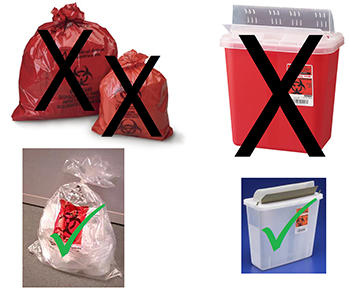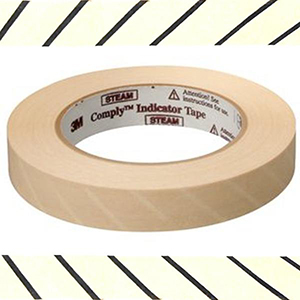Biohazard Waste Compliance Updates
 In the fall of 2015, IUPUI began an initiative requiring campus laboratories to switch to biohazard waste bags and sharps containers constructed of either clear, translucent or white plastic. The effort was initiated to harmonize the manner in which biological waste is handled throughout the Indiana University system and to mitigate other noted safety and waste handling concerns. In the fall of 2015, IUPUI began an initiative requiring campus laboratories to switch to biohazard waste bags and sharps containers constructed of either clear, translucent or white plastic. The effort was initiated to harmonize the manner in which biological waste is handled throughout the Indiana University system and to mitigate other noted safety and waste handling concerns.
Ongoing laboratory inspection efforts by Environmental Health and Safety (EHS) staff reveal that a number of campus labs have failed to complete this transition. Laboratory staff frequently indicate that the lab was never made aware of the requirement or that a special dispensation was issued for those labs having existing inventories of red sharps containers and/or bags.
The effort was initiated with the full support of the IUPUI Laboratory Safety Committee and the administration of the School of Science and the School of Medicine. The compliance date established at the start of the initiative was October 1, 2015. No other exemption from the requirement has been made.
Failure to make the conversion to the required disposal containers is in violation of the existing Indiana University Biosafety Manual and the Indiana University Bloodborne Pathogen Exposure Control Plan. EHS laboratory and biological safety inspectors are now marking this as a laboratory deficiency requiring immediate follow-up by the laboratory. Failure to correct the deficiency in a timely manner will result in a laboratory losing its right to treat and dispose of biohazard waste in-house and will result in the laboratory being required to use the services of a commercial biohazard waste disposal vendor at cost to the laboratory. Standardization of this process is essential in maintaining a safe and regulatory-compliant environment on campus.
 On another related note, EHS received an inquiry earlier this year whether standard and low-lead autoclave tape required any special handling or disposal. Staff had noted guidance documents on other university websites indicating that lead had been removed from the manufacture of autoclave tape dating back to 2008. On another related note, EHS received an inquiry earlier this year whether standard and low-lead autoclave tape required any special handling or disposal. Staff had noted guidance documents on other university websites indicating that lead had been removed from the manufacture of autoclave tape dating back to 2008.
In an effort to better understand the concern, EHS secured representative rolls of both standard and low-lead autoclave tape and subjected the tape to the specific analytical testing required to determine whether a waste meets the criteria of being a regulated hazardous waste.
The testing indicates that lead is still used in the manufacture of autoclave tape with standard tape testing at approximately 11,500 parts per million total lead. When used as intended, the tape is safe to use and handle. The tape should never be ingested and users should wash their hands following use and before eating.
Current environmental regulations do not require waste containers on which standard autoclave tape has been used to be managed in any special manner once treated for the biohazard concern. However, unused and unwanted rolls of tape do need to be referred to EHS for disposal as a chemical waste by completing the Waste Pick-Up Request Form. Lead was also detected in lead-free autoclave tape but at very low levels and below the regulatory threshold requiring any special handling or disposal. Please contact EHS at ehs@iupui.edu or by calling 274-2005 for additional assistance. |